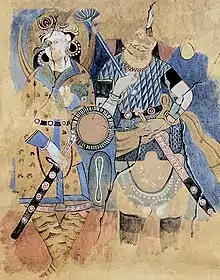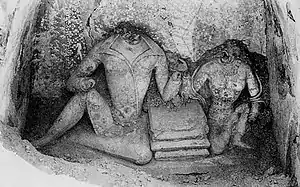Fondukistan monastery
The Fondukistan monastery was a Buddhist monastery located at the very top of a conical hill[1] next to the Ghorband Valley, Parwan Province, about 117 kilometers northeast of Kabul. The monastery dates to the early 8th century CE, with a terminus post quem in 689 CE obtained through numismatic evidence, so that the Buddhist art of the site has been estimated to around 700 CE.[2][3] This is the only secure date for this artistic period in the Hindu Kush, and it serves as an important chronological reference point.[3]
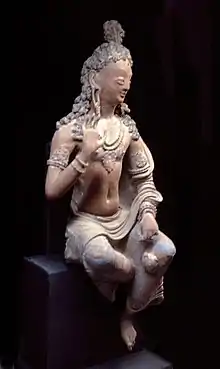 Seated Bodhisattva, Fondukistan monastery, circa 700 CE. Kabul Museum | |
 Shown within Afghanistan  Fondukistan monastery (Hindu-Kush) 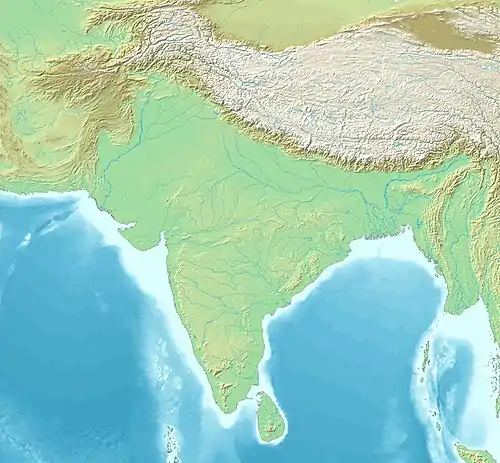 Fondukistan monastery (South Asia) 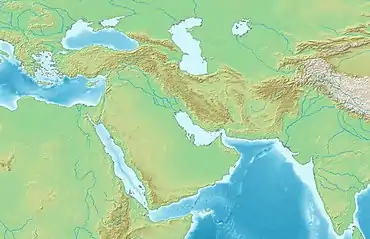 Fondukistan monastery (West and Central Asia) | |
| Coordinates | 34.957193°N 68.881672°E |
|---|---|
| Type | Monastery |
According to Benjamin Rowland “These little shrines, densely packed with sculptured figures set off by gaily painted backgrounds, must have given the effect of a kind of religious peep-show, in which, as on a stage, the visitor obtained a glimpse of celestial realms”.[4][5]
The works of art of the Fondukistan Monastery corresponds to a relatively high level of artistic activity in the areas controlled by the Buddhist Turk Shahis during 7-8th centuries CE, as a result of the continued development of Buddhist art, with possible Hephthalite influence, combined with the Sasanian cultural heritage.[6][5] The art of Fondukistan also corresponds to the last stages of Greco-Buddhist art in the 7-8th century CE.
During this period, the Chinese Tang Empire extended its influence and promotion of Buddhism to the Kingdoms of Central Asia, including Afghanistan, with a corresponding influx of Chinese monks, while there was conversely a migration of Indian monks from India to Central Asia, precisely looking for this protection.[7] These events gave rise to the hybrid Indian-Sinicized styles of Fondukistan and Tapa Sardar.[7] Similarities have also been noted with contemporary works of art in China, such as those of Tianlongshan.[8]
The monastery was excavated in 1936 by Joseph Hackin of the Délégation archéologique française en Afghanistan, and in 1937 by Jean Carl, from the same organization.[5] Most of the works of art that were recovered are now in the Musée Guimet, Paris.
Buddhist figures
 Statue of a Bodhisattva, Fondukistan. Circa 700 CE
Statue of a Bodhisattva, Fondukistan. Circa 700 CE Statue of the Buddha wearing the Iranian three-pointed camail, Ghorband valley, Fondukistan monastery, circa 700 CE.[9]
Statue of the Buddha wearing the Iranian three-pointed camail, Ghorband valley, Fondukistan monastery, circa 700 CE.[9]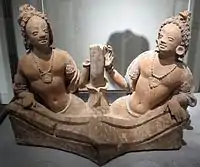 Naga kings, Ghorband valley, Fondukistan monastery, circa 700 CE
Naga kings, Ghorband valley, Fondukistan monastery, circa 700 CE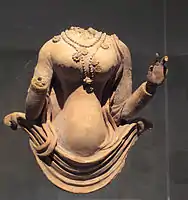 Female bust, Fondukistan. Musée des arts asiatiques Guimet.
Female bust, Fondukistan. Musée des arts asiatiques Guimet. Fondukistan monastery mural painting, circa 700 CE
Fondukistan monastery mural painting, circa 700 CE Seated Buddha, circa 700 CE
Seated Buddha, circa 700 CE
Central Asian figures
Various figures from the monastery show Central Asian influence, with dignitaries wearing double-lapel caftan, boots, armour and crown with lunar crescents.[11]
Dedications including coins of the Buddhist Turk Shahis (7-8th century CE) have been found under a statue of a royal couple in the monastery of Fondukistan, providing important insights in terms of datation.[12][13] The royal couple consists in a princess in “Indian” dress, and a prince "wearing a rich caftan with double lapel and boots" characteristic of Central Asian clothing.[14][15]
| Wikimedia Commons has media related to Fondukistan. |
References
- "Images of the Fondukistan monastery". Colorado State University.
- Verardi, Giovanni; Paparatti, Elio (2005). "From Early to Late Tapa Sardār: A Tentative Chronology". East and West. 55 (1/4): 432. ISSN 0012-8376. JSTOR 29757657.
- Novotny, Susanne (1 January 2007). "The Buddhist Monastery of Fondukistān, Afghanistan – A Reconstruction". Journal of Inner Asian Art and Archaeology. 2: 31–37. doi:10.1484/J.JIAAA.2.302542. ISSN 1783-9025.
- Rowland and Rice, Ancient Art of Afghanistan, p. 45
- "FONDOQESTĀN – Encyclopaedia Iranica". iranicaonline.org.
- Compareti, Matteo (2008). "The Painting of the "Hunter-King" at Kakrak: Royal Figure or Divine Being?". Studio Editoriale Gordini: 133.
- Verardi, Giovanni; Paparatti, Elio (2005). "From Early to Late Tapa Sardār: A Tentative Chronology". East and West. 55 (1/4): 437–438. ISSN 0012-8376. JSTOR 29757657.
- "Stylistic similarities between the images of Fonduqistan and late Tapa Sardar and the early 8th-century Tang production of Tianlongshan have been noted, and the existence of a 'common international style' inclusive of Tang China and the regions to the west and south of the Pamir has been suggested" in Verardi, Giovanni; Paparatti, Elio (2005). "From Early to Late Tapa Sardār: A Tentative Chronology". East and West. 55 (1/4): 433. ISSN 0012-8376. JSTOR 29757657.
- Compareti, Matteo (2009). "Iranian Elements in Kaśmīr and Tibet Sasanian and Sogdian Borrowings in Kashmiri and Tibetan Art". Transoxiana. 14.
- Hackin, J. (1938). "Les travaux de la Délégation archéologique française en Afghanistan: COMPTE-RENDU SOMMAIRE (SEPTEMBRE 1936-AOÛT 1937)". Revue des arts asiatiques. 12 (1): 10–11. ISSN 0995-7510. JSTOR 43475079.
- Hackin, J. (1938). "Les travaux de la Délégation archéologique française en Afghanistan: COMPTE-RENDU SOMMAIRE (SEPTEMBRE 1936-AOÛT 1937)". Revue des arts asiatiques. 12 (1): 10–11. ISSN 0995-7510. JSTOR 43475079.
- ALRAM, MICHAEL (2014). "From the Sasanians to the Huns New Numismatic Evidence from the Hindu Kush" (PDF). The Numismatic Chronicle (1966-). 174: 282–285. ISSN 0078-2696. JSTOR 44710198.
- For the photograph of the famous statue, named the "Royal Couple of Fondukistan", see: "FONDOQESTĀN – Encyclopaedia Iranica". iranicaonline.org.
- "Fondukistan Digitaler Ausstellungskatalog". pro.geo.univie.ac.at. Kunsthistorisches Museum Vienna.
- Hackin, J. (1938). "Les travaux de la Délégation archéologique française en Afghanistan: COMPTE-RENDU SOMMAIRE (SEPTEMBRE 1936-AOÛT 1937)". Revue des arts asiatiques. 12 (1): 10–11. ISSN 0995-7510. JSTOR 43475079.
- Hackin, J. (1938). "Les travaux de la Délégation archéologique française en Afghanistan: COMPTE-RENDU SOMMAIRE (SEPTEMBRE 1936-AOÛT 1937)". Revue des arts asiatiques. 12 (1): 10–11. ISSN 0995-7510. JSTOR 43475079.
- Alram, Michael; Filigenzi, Anna; Kinberger, Michaela; Nell, Daniel; Pfisterer, Matthias; Vondrovec, Klaus. "The Countenance of the other (The Coins of the Huns and Western Turks in Central Asia and India) 2012-2013 exhibit: 12. ZABULISTAN: FROM THE ALKHAN-NEZAK CROSSOVER TO THE TURKS". Pro.geo.univie.ac.at. Kunsthistorisches Museum Vienna. Retrieved July 16, 2017.
- A recent detailed view: "Les trésors sataniques - Satanic treasures PATRICK CHAPUIS PHOTOGRAPHE". patrickchapuis.photoshelter.com.
Sources
- J. Hackin, “Le monastère bouddhique de Fondukistan (fouilles de J. Carl, 1937),” MDAFA 8, 1959, pp. 49-58.
- J. Hackin, “The Buddhist Monastery of Fondukistan,” Afghanistan (Kabul) 5/2, 1950, pp. 19-35.
